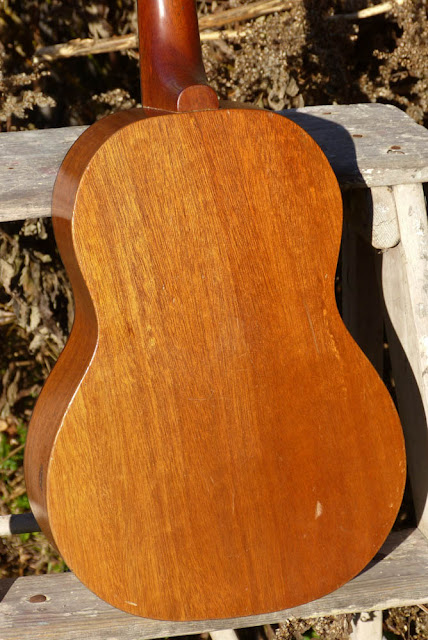1950s Harmony Baritone Ukulele
Harmony baris from the 50s are reliably good players after they've been tweaked and setup properly. They're also stable and practical. These are the reasons that I've done-over so very many of them. Some of the 60s ones can be as good as the 50s ones, but generally the older Harmony baris are the best -- they have thinner body woods and better quality wood overall. The bridge and board are both Brazilian rosewood, the body and neck are solid mahogany, and the nut and saddle are bone.
My work on this one included a resculpt of the bridge (to a pin-mounted style), fret level/dress, one brace repair, cleaning, and setup (slightly under 3/32" action at the 12th fret which I do standard on baris these days) with a set of GHS standard "black nylon" bari strings. I like these strings as a starting point because the tension feels balanced, they last a long time, and have good volume. They're also a little warmer than other sets so they suit the mellow character of the Harms.
There are no cracks on the top or sides, but there is a tiny hairline on the back and a small filled-in hole on the treble side.
There's the standard 40s/50s Harmony decal... and the original bone nut.
The dots are "pearloid" rather than pearl and the frets are old brass stock.
I converted this from a classical "tie block" rear to this pin-bridge rear (like on many Martin tenor ukes) to get better back-angle on the saddle. Harmony tended to drill the "through holes" for the strings on their tie-blocks really high up and so when the saddle gets shaved down to improve action the back-angle is lost and tone suffers. This solves that and looks snazzy, too. The plastic pins are old ones from my bins.
There's some general use-wear throughout but the uke is actually pretty clean for its age.
I left the original friction pegs on as they were working just fine.
I like the faux-tortoise binding on these -- looks good against that mahogany.
Here's that small patch on the treble side (right at your knee). It looks like someone had tape or a band-aid over it at one point, too -- hee hee.
This is that tight, good-to-go hairline crack at the rear waist.

















Comments